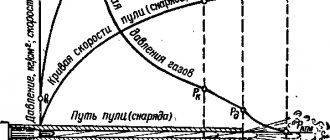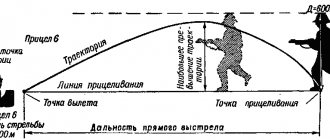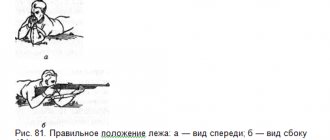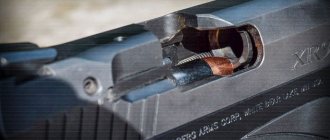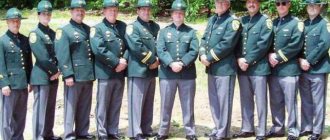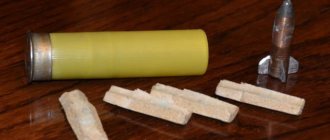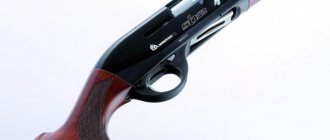Weapon recoil and departure angle
Weapon recoil
Recoil is the backward movement of the weapon (barrel) during a shot. Recoil is felt in the form of a push to the shoulder, arm or ground.
The recoil action of a weapon is characterized by the amount of speed and energy it has when moving backwards.
The recoil speed of a weapon is approximately the same number of times less than the initial speed of a bullet, how many times the bullet is lighter than the weapon.
The recoil energy of hand-held small arms usually does not exceed 2 kgm and is perceived painlessly by the shooter.
When firing from an automatic weapon, the design of which is based on the principle of using recoil energy, part of it is spent on imparting movement to moving parts and on reloading the weapon. Therefore, the recoil energy when fired from such a weapon is less than when fired from a non-automatic weapon or from an automatic weapon, the design of which is based on the principle of using the energy of powder gases discharged through a hole in the barrel wall.
The pressure force of the powder gases (recoil force) and the recoil resistance force (butt stop, handle, center of gravity of the weapon, etc.) are not located on the same straight line and are directed in opposite directions. They form a pair of forces, under the influence of which the muzzle of the weapon barrel is deflected upward. The greater the leverage of this pair of forces, the greater the deflection of the muzzle of a given weapon.
In addition, when fired, the barrel of the weapon makes oscillatory movements - vibrates. As a result of vibration, the muzzle of the barrel at the moment the bullet leaves can also deviate from its original position in any direction (up, down, right, left). The magnitude of this deviation increases when the shooting rest is used incorrectly, the weapon is dirty, etc.
In an automatic weapon that has a gas outlet in the barrel, as a result of gas pressure on the front wall of the gas chamber, when fired, the muzzle of the weapon barrel is slightly deflected in the direction opposite to the location of the gas outlet.
The combination of the influence of barrel vibration, weapon recoil and other reasons leads to the formation of an angle between the direction of the axis of the barrel bore before the shot and its direction at the moment the bullet leaves the bore; this angle is called the departure angle (γ).
The departure angle is considered positive when the axis of the barrel bore at the moment the bullet leaves is above its position before the shot, and negative when it is below. The take-off angle is given in the shooting tables.
The influence of the take-off angle on the shooting of each weapon is eliminated when it is brought back to normal combat. However, if the rules for placing a weapon, using a rest, as well as the rules for caring for and preserving a weapon are violated, the angle of departure and the engagement of the weapon change. To ensure uniformity of the launch angle and reduce the impact of recoil on shooting results, it is necessary to strictly follow the shooting techniques and rules for caring for weapons specified in the shooting manuals.
Throwing up the muzzle of the barrel when firing as a result of recoil
In order to reduce the harmful effects of recoil on shooting results, some types of small arms (for example, a Kalashnikov assault rifle) use special devices - compensators.
The gases flowing from the bore, hitting the walls of the compensator, slightly lower the muzzle of the barrel to the left and down. Tags: fire training
Weapon recoil (departure angle formation)
The movement of the barrel and associated weapon parts in the direction opposite to the movement of the bullet (projectile) during a shot under the influence of powder gas pressure is called recoil
.
In the phenomenon of recoil, we are interested in its speed and energy, as well as the nature of the weapon’s movement. In guns, the recoil force is perceived by a tank or infantry fighting vehicle through a recoil device; when firing from small arms, it is perceived by the hand, shoulder, installation or ground. The more powerful the weapon, the greater the recoil energy: from 20 N/m for a pistol to, for example, 120 N/m for a 100 mm gun. The direction of action of the recoil force and the recoil resistance force are located with an offset on a certain shoulder. The dynamic pair of forces thus formed leads to a circular movement of the weapon. Deviations can also occur due to the influence of the automatic action of small arms and the dynamic bending of the barrel as a bullet moves along it. These reasons lead to the formation of an angle between the direction of the axis of the barrel bore before the shot and its direction at the moment the bullet leaves the bore. This angle is called the take-off angle, the value of which in the vertical plane is given in the small arms shooting tables. The greater the leverage of this pair of forces, the greater the deflection of the muzzle of the weapon barrel (departure angle).
| after the shot |
Axis
| The axis of the bore before the shot |
| departure angle |
Rice. 6. Pairs of forces that deflect the barrel of a pistol or revolver to the top and to the left
When shooting from a pistol (revolver), the recoil is felt by the hand. The counteraction of the hand is also the reaction force that is directed in the opposite direction and is equal to the recoil force. Since, when gripping the handle of a pistol or revolver, the middle part of the hand is located below and to the right of the axis of the barrel, the recoil force and reaction force create pairs of forces that rotate the weapon in the vertical and horizontal planes. Let's consider the recoil phenomenon of a self-loading blowback pistol.
Under the influence of the pressure of the powder gases, the bullet accelerates along the barrel from 0 to Vn, while at the same time the bolt, under the influence of the same powder gases through the bottom of the cartridge case, accelerates in the opposite direction at a speed from 0 to Vtd (the principle of operation of automatic weapons with a blowback). When the bullet leaves the barrel, the powder gases cease to affect the bolt, which, having picked up speed Vtd, continues to move backward by inertia, extracting the spent cartridge case, cocking the hammer and compressing the return spring. The bolt expends some of its kinetic energy to cock the hammer and compress the return spring. At the same time, its speed is reduced to Vк, with which the bolt hits the pistol frame at the end of the rollback. It is at this moment that the shooter's hand will feel the main recoil.
The recoil speed of the free shutter for the PM will be equal to 7.68 m/sec.[1]
If we accept the assumptions that the speed of the bullet increases according to a linear relationship, the distance of the bullet along the barrel is determined based on the geometric parameters of the pistol and is equal to 82.85 mm. The firing time for the PM will be 0.00053 seconds.
When the bullet leaves the barrel, the bolt moves back by 2 mm, while the shooter’s hand feels almost nothing, and the departure angle is quite small.
The take-off angle for a specific weapon is an almost constant value and is taken into account when bringing the weapon to normal combat.
The hand begins to perceive the recoil directly when the hammer is cocked by the bolt and the return spring is compressed, and the main push comes from the impact of the bolt at a speed of 3.82 m/sec. about the pistol frame in 0.007 sec. after the bullet leaves, which during this time manages to move away from the pistol by 2.2 m according to calculations for the PM.
From all that has been said, the most important conclusion must be drawn: the recoil of the PM does not affect the shooting accuracy! If you hold the gun only with the tips of your thumb and middle finger, and press the trigger with your index finger, the bullet will still hit the target accurately, although the weapon will be torn out of the hand during recoil.
To reduce recoil and take-off angle, devices are installed in small arms - compensators, a muzzle brake - compensator.
Muzzle brakes are devices connected to the muzzle of the barrel and used to reduce recoil energy. Muzzle brakes can be active, reactive or combined:
– active muzzle brakes – the front wall has a large surface;
– reactive muzzle brakes – windows, the edges of which are cut at an angle back;
– a combined brake combines the operating principles of active and reactive brakes.
Muzzle brakes absorb up to 30–40% of recoil energy. The disadvantages of muzzle brakes include the following factors:
– the flow of powder gases is deflected towards the shooter;
– the sharpness of the shot sound increases;
– the weapon is unmasked by dust raised by gases hitting the surface of the earth.
Types of trajectories and their practical significance
When firing from any type of weapon with an increase in elevation angle from 0° to 90°, the horizontal range first increases to a certain limit and then decreases to zero.
|
The angle of elevation at which the greatest range is obtained is called the angle of greatest range. The maximum range angle for bullets of various types of weapons is about 45°.
The angle of greatest range divides all trajectories into two types: flat and mounted trajectories.
| Flat trajectories are trajectories obtained at elevation angles less than the angle of greatest range. Mounted trajectories are called trajectories obtained at elevation angles greater than the angle of greatest range. Conjugate trajectories are trajectories obtained at the same horizontal distance by two trajectories, one of which is flat, the other is mounted. |
When firing from small arms and grenade launchers, only flat trajectories are used. The flatter the trajectory, the greater the area over which the target can be hit with one sight setting (the less impact an error in determining the sight setting has on the shooting results): this is the practical significance of the trajectory.
The flatness of the trajectory is characterized by its greatest excess above the aiming line. At a given range, the trajectory is flatter the less it rises above the aiming line. In addition, the flatness of the trajectory can be judged by the magnitude of the angle of incidence: the smaller the angle of incidence, the more flat the trajectory. The flatness of the trajectory affects the range of the direct shot, the target, covered and dead space.
A straight shot is a shot in which the trajectory of the bullet does not rise above the target over the entire firing distance.
| The phenomenon of a direct shot is used in tense moments of battle when there is a shortage of time, when you need to move all the time and there is no time to set the sight in range, while the aiming point in height is usually chosen at the lower edge of the target. The range of a direct shot depends on the height of the target and the flatness of the trajectory. |
The higher the target and the flatter the trajectory, the greater the range of a direct shot and the greater the area over which the target can be hit with one sight setting.
The direct shot range can be determined from tables by comparing the target height with the values of the greatest elevation of the trajectory above the aiming line or with the trajectory height. For the AK74 assault rifle, the range of a direct shot at a chest figure is 440 m, and at a running figure – 625 m.
A direct shot in defense when repelling an attack from an advancing enemy from an AK74 is usually made at a range of 600 meters with a “6” sight and the aiming point all the time at the enemy’s heels. Why is that? The average height of a running and crouching soldier in an attack is considered to be 150 cm. In reality, he is distinguishable by 600 meters. Using the table of excess of average trajectories, we find its most suitable height, not exceeding the height of the target at a distance of 600 meters. It will be equal in the middle (top) of the trajectory at a distance of 300 meters - 120 cm with a scope “6”; at 400 meters with the same sight “6” - 110 cm; at 500 meters with sight “6” - 82 cm.
Therefore, aiming at the feet of an advancing infantryman with a “6” scope, starting from a distance of 600 meters and closer as he approaches, you can shoot without moving the scope. The enemy will be hit first in the legs, then in the stomach, chest, and head. Upon reaching a distance of 300 meters (the top of the trajectory), the enemy will be hit in the head, chest, stomach and again in the legs.
The direct shot method is convenient in defense, when repelling an enemy attack, when there is no time to set the sight at constantly changing firing distances, and it does not matter where the enemy is hit - it is important that he does not reach you.
In this case, aiming for the head is an unnecessary luxury. It is more important to shoot more often so that the enemy’s attack quickly succumbs. If you really want to “hook” the enemy “abruptly”, keep in mind the following: at a distance of 600 meters the bullet will fall at the aiming point, that is, at the heels, and therefore at this distance you need to aim higher, somewhere in the area of the knees or above, in the waist if you want to hit the center. But closer, at 500 meters, you need to shoot at the heels - the trajectory itself will lead the bullet where it needs to be. At close range, 100 meters, the bullet will also go down (the excess at this distance will be 0.54 cm), so you also need to aim above the knees and below the buckle to hit the chest. But at all other distances, from 500 to 100 meters, as the attacking enemy approaches, the aiming point must be taken only along the horizon, “along the heels,” without changing the height of the sight.
During offensive actions when shooting, a direct shot results in:
— at an entrenched target (height 30 cm) with scope “3” at a distance of up to 300 meters;
— at an open target (height 50 cm) with a “4” or “P” sight at a distance of up to 400 meters;
— at a running target (height 1.5 m) with scope “6” at a distance of up to 600 meters.
